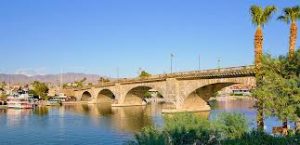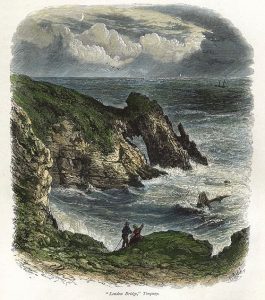For decades anyone sitting their GCSE Geography exam was prepared for a question about sea arches. It would be along the lines of “What is a sea arch? Can you name a sea arch you have seen?”
Unlike residents of landlocked Birmingham, here in the Bay we certainly could identify a sea arch – the oddly named and impressive London Bridge near Torquay Harbour. This is a Middle Devonian limestone natural arch where less resistant limestone has been eroded away.
But why is our natural arch called London Bridge? We certainly have a tendency to name parts of our town after locations in London – for example, Pimlico, Grosvenor, and Belgravia. This is because we wanted to promote Torquay’s sophistication to affluent nineteenth century visitors and to make them feel at home on their extended vacations.
Yet London Bridge has been known as such for centuries and the name was in use long before Torquay came into existence as a town. Arthur Charles Ellis in his 1930 ‘An Historical Survey of Torquay’ discusses the origin of the name. He quotes JT White from 1878 who wrote, “There was a grand sandstone arch at Corbon Head which vied in beauty with the more durable limestone arch on the other side of the bight locally known as ‘London Bridge’.” The image below is from around 1895.
The designation goes back even further, however, and caused confusion. In 1832 Octavian Blewitt wrote in his ‘The panorama of Torquay: a descriptive and historical sketch of the district comprised between the Dart and Teign’, that London Bridge was an “absurd appellation”. Ellis notes that, “The explanation for the name often given is that it comes from the same granite as London Bridge”. Yet, he rightly points out that the New Bridge in London was only built in 1831, and the name is older than that. He doesn’t, however, note that our arch is limestone and not granite.
And Blewitt was right. There isn’t much of a resemblance to the fine New London Bridge he was familiar with, which was based on five wide stone arches and opened in 1831 – pictured above. This New Bridge was 928 feet long and 49 feet wide, and constructed from Dartmoor granite. Incidentally, spare corbels – a type of stone bracket to carry weight – for London Bridge were left behind at Swelltor Quarry on Dartmoor. They still lie beside the former narrow gauge Plymouth and Dartmoor Railway – see below.
Bizarrely, that bridge was dismantled in 1967 and relocated to a lake in the desert of Arizona, a planned community established in 1964 on the shore of Lake Havasu – below.
But what if our arch was named after a much older London Bridge? There is a Torquay map made by Matthew Blackmore in 1769 which features ‘London Bridge’. This map is, “within an ornamental border surmounted by a parrot with extended wings; and below showing an illustration of fruit, plan of the manor of Tormoham in the said parish and property of Robert Palk esquire”. It had nine membranes of parchment, about six feet square and was “practically perished” even back in the early nineteenth century.
So we were calling our sea arch ‘London Bridge’ at least as far back as the mid eighteenth century. And if we then consider what the original bridge in the capital looked like at that time, we may have a better idea of the motivation for naming our landmark. The original Old London Bridge began construction in 1176 and was finished in 1209 during the reign of King John. The bridge was some 26 feet wide, and about 900 feet long, supported by 19 irregularly spaced arches. It had a drawbridge to allow for the passage of tall ships, and defensive gatehouses at both ends. By 1358, it was already crowded with 138 shops – by the Tudor era there were 200 buildings on the bridge, some seven storeys high, which overhung the river by seven feet. Here’s Old London Bridge from Claude de Jongh’s 1632 oil painting:
Perhaps significantly, the difference in water levels on the two sides of the bridge could be as much as 6 feet which, along with narrow arches and wide pier bases, produced ferocious rapids between the piers resembling a weir. Only the brave or foolhardy attempted to “shoot the bridge” – steer a boat between the starlings surrounding the supports of the bridge when in flood – and some were drowned attempting to do so. The bridge was “for wise men to pass over, and for fools to pass under.” Navigating a small boat near the cliffs by Torquay Harbour can similarly be a dangerous undertaking as can be seen in the image below.
Another connection could be the well-known nursery rhyme ‘London Bridge is Falling Down’ which may date back to the Late Middle Ages, and deals with the depredations of London Bridge and attempts to repair it. Records of the rhyme date from the seventeenth century – the earliest reference being in the comedy ‘The London Chaunticleres’ from around 1636. Could the same song have been utilised by Torquinians as their cliffs fell away over the years?
So was our London Bridge named by someone who had seen the narrow irregular arches and hazardous tidal rapids of the medieval London Bridge? Were they reminded of the nursery rhyme as Torquay’s arch crumbled? We’ll never know for sure. What we do know is that we have a striking local landmark with an unusual name.
Here’s a closer look at our London Bridge:


































